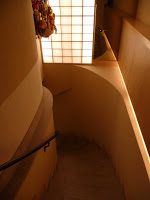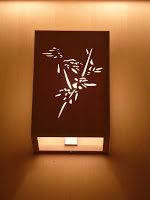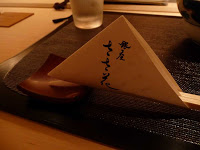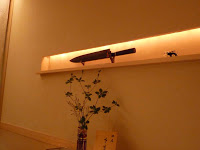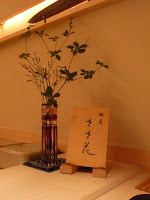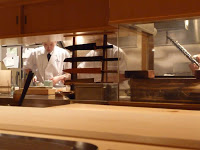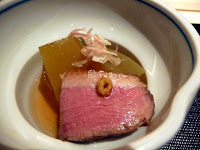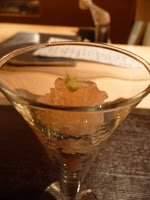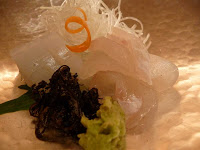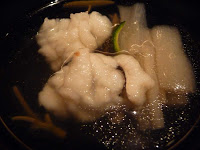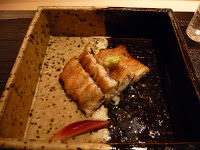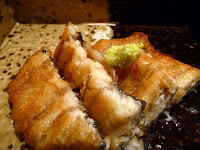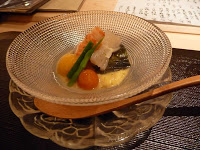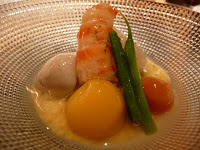Sasahana is up in the northeast corner of The Ginza, behind Printemps or Marronier or Velvia (as you like). After seeing the door, I realized that I walked by right around the same time last year, picked up a brochure, and never thought any more of it. Glad I went back!
It’s not a particularly interesting street – I back up that statement by saying that my last company party was in an adjoining building. But the door immediately gives you an indication that there’s something special inside. Like the late, lamented Monya in Roppongi, when you duck under the noren, you’re in a different world. The stairs curve around mysteriously, the lighting is soft and warm, and they’ve prepared a place for you at the counter.
There are lots of little details – like the master’s special knife that he takes down only to carve sashimi for regular customers (normal folks like me get one of the assistants and a knife from the regular rack). Everything is very light but soft, with 8 seats at the counter, a table room and a horikotatsu room. Total capacity is less than 30, but hovered around 10 while I was there, which is amply covered by the 4 chefs and 2 service people. In the kitchen picture, you can see not only the knife rack but also the grill, where they continually replenish the charcoal. The diagonal thing is a tachiuo being turned over (this is seasonal, looks like a sanma, and has similarly confusing kanji – 太刀魚 instead of 秋刀魚); a steady stream of these was cooked and served, but not to me.
There are three kaiseki courses here, although it seems regulars tend to order a la carte, which is perfectly fine. Below is the mid level ‘Gin’ course (the name of which should be familiar if you’re used to seeing 龍吟, Ryu-gin in posts by wealthy food tourists). I’m not sure how I ended up at kaiseki for this dinner; it’s so hot at the moment that I didn’t feel like eating much of anything, and summer generally isn’t that exciting for most fish and meats. The chefs at Sasahana did a great job of turning out interesting things that were seasonal and cool though. And in a bizarre and ironic twist, given that I spent all of the preceding week eating eel for lunch, three of the courses were eel in various forms!
Above are the winter melon (tougan, 冬瓜, why the heck is a summer vegetable called ‘winter’?) and roast duck, served cold and drenched in an excellent broth. The melon was barely cooked, so it was soft but the skin was still firm. That contrast really made the dish. The cocktail glass is in fact filled with cold eel, but with a nice and refreshing twist. This type of eel, hamo, is popular only in summer, and is famous for being bony – too bony to de-bone. So famous, in fact, that some makers have a special knife intended just for cutting up the bones so that the fish is edible, tiny bone fragments and all. The normal way to eat hamo is boiled and chilled, with a thick, sour plum sauce. In this case they mixed things up a touch by offering the plum as umeboshi jelly – much lighter and more sophisticated. It’s these little touches, and the references contained in them, that make kaiseki a lot more fun. Third picture, sashimi. In an odd twist, the raw squid was terrific, just a great piece of squid. The flounder was also interesting because they served it with thinly sliced seaweed. A common way to eat flounder is to wrap it in seaweed for a day or two. Originally this was for preservation, now it’s just because the taste is interesting and the texture firms up. But you get some of the same flavor, without the textural changes, by eating the salted seaweed tangles with it.
Hot dishes were limited in quantity, and limited to eel. The first dish is hamo; I have to say, I never liked hamo that much, but I sure do now. This was delicious – soft and flavorful and no boniness or chewiness at all. One of those moments when you say “I didn’t know you could do that with this ingredient!” The soup was a different but equally excellent clear broth (not the same as the tougan), and the accompanying vegetables are simmered onions and new potato stalks (zuiki – I have to put that in because I actually still remember it. My mnemonic is “zoo ni ikimasuka?”). I cringed a little when I saw the next dish – straight up wild-caught eel roasted over charcoal with little sauce and moistened with dashi – but it was likely the best eel I had all week. Without sauce you could really taste the quality of the eels, and for some reason Sasahana had taken the care to crisp up the skin, which is a (thoroughly delicious) rarity. More of this would have been welcome, but I guess you’re supposed to want more after every course. It may quite possibly have been the best eel I had all week.
After that it was back to cold things for the most part – a quick interlude of boiled spinach and fried tofu, a very homey sort of vinegar dish, was followed by the house special. This could be described as ‘boiled seasonal vegetables with creamed corn’, but the individually cooked and balled carrot, pumpkin, potato and eggplant, on a bed of pureed sweet corn, topped with a shrimp and a few beans, was restorative and incredibly delicious. If you get the separate dish and not the course it’ll be bigger and come in a hollowed hemisphere of pumpkin, which is even better looking.
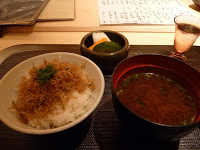
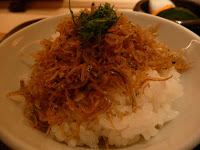 Excellent soup, almost tasted like there was consomme in the broth but I didn’t ask. I should have, because the master was thoroughly accomodating and eager to answer questions in detail. The rice was good too, and I present the close-up only so you can see the fish heads, eyes and spines up close. Yum.
Excellent soup, almost tasted like there was consomme in the broth but I didn’t ask. I should have, because the master was thoroughly accomodating and eager to answer questions in detail. The rice was good too, and I present the close-up only so you can see the fish heads, eyes and spines up close. Yum.
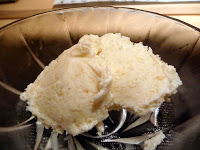 Dessert was a simple scoop of sesame ice cream – so humble, yet so delicious. A perfect end to a lovely meal! Just kidding. It was nice, but boring and a little icy. I just like making fun of kaiseki dessert courses and the people who claim to love them.
Dessert was a simple scoop of sesame ice cream – so humble, yet so delicious. A perfect end to a lovely meal! Just kidding. It was nice, but boring and a little icy. I just like making fun of kaiseki dessert courses and the people who claim to love them.
This was a very good restaurant! My main source of confusion was why the prices were pretty low considering the high quality. I think I understand now – the quantities are pretty low. You can eat more rice if you want, but it’s a smallish meal. That would explain why the done thing is to order off the menu, as the regulars were doing. ‘Regular’ status is something to aspire to here; they’re friendly and professional, and it would be tough not to enjoy a visit.
Awesome web site too.
03-3561-3761
